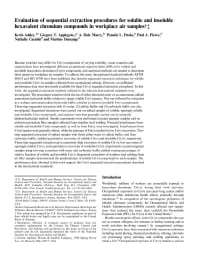Mining Publication: Evaluation of Sequential Extraction Procedures for Soluble and Insoluble Hexavalent Chromium Compounds in Workplace Air Samples
Original creation date: February 2009
Authors: KE Ashley, GT Applegate, AD Marcy, PL Drake, PA Pierce
Because toxicities may differ for Cr(VI) compounds of varying solubility, some countries and organizations have promulgated different occupational exposure limits (OELs) for soluble and insoluble hexavalent chromium (Cr(VI)) compounds, and analytical methods are needed to determine these species in workplace air samples. To address this need, international standard methods ASTM D6832 and ISO 16740 have been published that describe sequential extraction techniques for soluble and insoluble Cr(VI) in samples collected from occupational settings. However, no published performance data were previously available for these Cr(VI) sequential extraction procedures. In this work, the sequential extraction methods outlined in the relevant international standards were investigated. The procedures tested involved the use of either deionized water or an ammonium sulfate/ ammonium hydroxide buffer solution to target soluble Cr(VI) species. This was followed by extraction in a sodium carbonate/sodium hydroxide buffer solution to dissolve insoluble Cr(VI) compounds. Three-step sequential extraction with (1) water, (2) sulfate buffer and (3) carbonate buffer was also investigated. Sequential extractions were carried out on spiked samples of soluble, sparingly soluble and insoluble Cr(VI) compounds, and analyses were then generally carried out by using the diphenylcarbazide method. Similar experiments were performed on paint pigment samples and on airborne particulate filter samples collected from stainless steel welding. Potential interferences from soluble and insoluble Cr(III) compounds, as well as from Fe(II), were investigated. Interferences from Cr(III) species were generally absent, while the presence of Fe(II) resulted in low Cr(VI) recoveries. Two-step sequential extraction of spiked samples with (first) either water or sulfate buffer, and then carbonate buffer, yielded quantitative recoveries of soluble Cr(VI) and insoluble Cr(VI), respectively. Three-step sequential extraction gave excessively high recoveries of soluble Cr(VI), low recoveries of sparingly soluble Cr(VI), and quantitative recoveries of insoluble Cr(VI). Experiments on paint pigment samples using two-step extraction with water and carbonate buffer yielded varying percentages of relative fractions of soluble and insoluble Cr(VI). Sequential extractions of stainless steel welding fume air filter samples demonstrated the predominance of soluble Cr(VI) compounds in such samples. The performance data obtained in this work support the Cr(VI) sequential extraction procedures described in the international standards.

- Comparison of Methane Concentrations at a Simulated Coal Mine Face During Bolting
- Criteria for a Recommended Standard: Occupational Exposure to Respirable Coal Mine Dust: Occupational Exposure to Respirable Coal Mine Dust
- Field Method for the Determination of Insoluble or Total Hexavalent Chromium in Workplace Air
- In-Mine Evaluation of Smart Mine Fire Sensor
- Miners' Views about Personal Dust Monitors
- Miners' Views About Personal Dust Monitors
- Real-time Neural Network Application to Mine Fire - Nuisance Emissions Discrimination
- Sonic Anemometer Airflow Monitoring Technique for Use in Underground Mines
- A Technique for Measuring Toxic Gases Produced by Blasting Agents
- Use of Vacutainers for Collection of Mine Atmosphere Samples